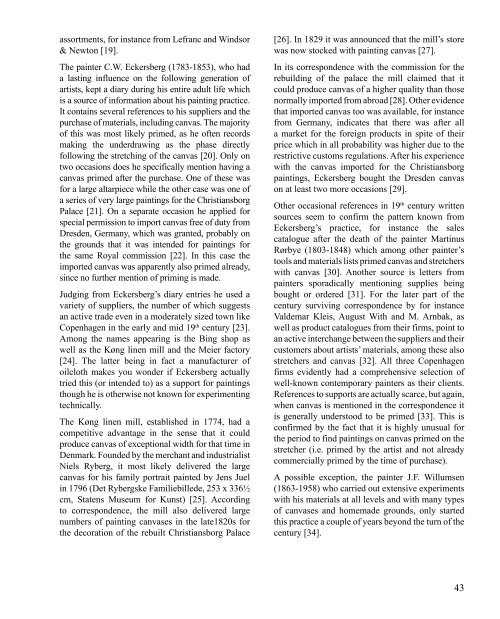dk nkf - Nordisk Konservatorforbund Danmark
dk nkf - Nordisk Konservatorforbund Danmark
dk nkf - Nordisk Konservatorforbund Danmark
Create successful ePaper yourself
Turn your PDF publications into a flip-book with our unique Google optimized e-Paper software.
assortments, for instance from Lefranc and Windsor<br />
& Newton [19].<br />
The painter C.W. Eckersberg (1783-1853), who had<br />
a lasting influence on the following generation of<br />
artists, kept a diary during his entire adult life which<br />
is a source of information about his painting practice.<br />
It contains several references to his suppliers and the<br />
purchase of materials, including canvas. The majority<br />
of this was most likely primed, as he often records<br />
making the underdrawing as the phase directly<br />
following the stretching of the canvas [20]. Only on<br />
two occasions does he specifically mention having a<br />
canvas primed after the purchase. One of these was<br />
for a large altarpiece while the other case was one of<br />
a series of very large paintings for the Christiansborg<br />
Palace [21]. On a separate occasion he applied for<br />
special permission to import canvas free of duty from<br />
Dresden, Germany, which was granted, probably on<br />
the grounds that it was intended for paintings for<br />
the same Royal commission [22]. In this case the<br />
imported canvas was apparently also primed already,<br />
since no further mention of priming is made.<br />
Judging from Eckersberg’s diary entries he used a<br />
variety of suppliers, the number of which suggests<br />
an active trade even in a moderately sized town like<br />
Copenhagen in the early and mid 19 th century [23].<br />
Among the names appearing is the Bing shop as<br />
well as the Køng linen mill and the Meier factory<br />
[24]. The latter being in fact a manufacturer of<br />
oilcloth makes you wonder if Eckersberg actually<br />
tried this (or intended to) as a support for paintings<br />
though he is otherwise not known for experimenting<br />
technically.<br />
The Køng linen mill, established in 1774, had a<br />
competitive advantage in the sense that it could<br />
produce canvas of exceptional width for that time in<br />
Denmark. Founded by the merchant and industrialist<br />
Niels Ryberg, it most likely delivered the large<br />
canvas for his family portrait painted by Jens Juel<br />
in 1796 (Det Rybergske Familiebillede, 253 x 336½<br />
cm, Statens Museum for Kunst) [25]. According<br />
to correspondence, the mill also delivered large<br />
numbers of painting canvases in the late1820s for<br />
the decoration of the rebuilt Christiansborg Palace<br />
[26]. In 1829 it was announced that the mill’s store<br />
was now stocked with painting canvas [27].<br />
In its correspondence with the commission for the<br />
rebuilding of the palace the mill claimed that it<br />
could produce canvas of a higher quality than those<br />
normally imported from abroad [28]. Other evidence<br />
that imported canvas too was available, for instance<br />
from Germany, indicates that there was after all<br />
a market for the foreign products in spite of their<br />
price which in all probability was higher due to the<br />
restrictive customs regulations. After his experience<br />
with the canvas imported for the Christiansborg<br />
paintings, Eckersberg bought the Dresden canvas<br />
on at least two more occasions [29].<br />
Other occasional references in 19 th century written<br />
sources seem to confirm the pattern known from<br />
Eckersberg’s practice, for instance the sales<br />
catalogue after the death of the painter Martinus<br />
Rørbye (1803-1848) which among other painter’s<br />
tools and materials lists primed canvas and stretchers<br />
with canvas [30]. Another source is letters from<br />
painters sporadically mentioning supplies being<br />
bought or ordered [31]. For the later part of the<br />
century surviving correspondence by for instance<br />
Valdemar Kleis, August With and M. Arnbak, as<br />
well as product catalogues from their firms, point to<br />
an active interchange between the suppliers and their<br />
customers about artists’ materials, among these also<br />
stretchers and canvas [32]. All three Copenhagen<br />
firms evidently had a comprehensive selection of<br />
well-known contemporary painters as their clients.<br />
References to supports are actually scarce, but again,<br />
when canvas is mentioned in the correspondence it<br />
is generally understood to be primed [33]. This is<br />
confirmed by the fact that it is highly unusual for<br />
the period to find paintings on canvas primed on the<br />
stretcher (i.e. primed by the artist and not already<br />
commercially primed by the time of purchase).<br />
A possible exception, the painter J.F. Willumsen<br />
(1863-1958) who carried out extensive experiments<br />
with his materials at all levels and with many types<br />
of canvases and homemade grounds, only started<br />
this practice a couple of years beyond the turn of the<br />
century [34].<br />
43

















